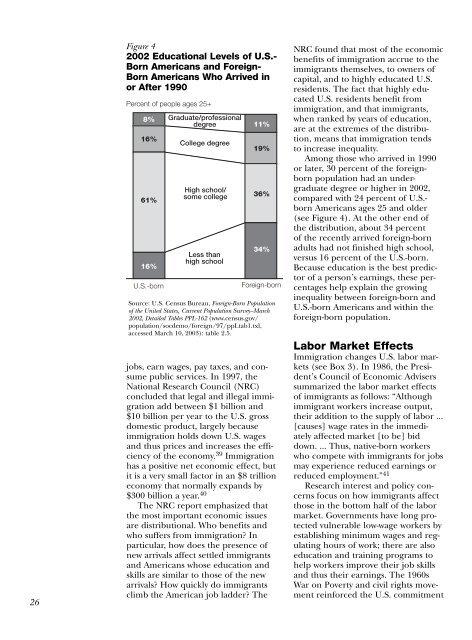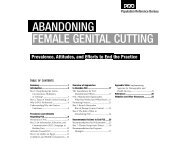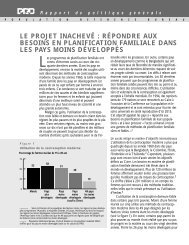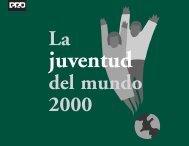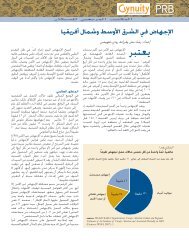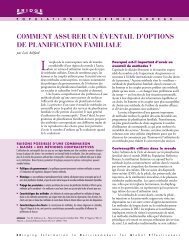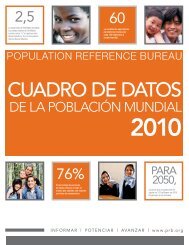Immigration Shaping America - Population Reference Bureau
Immigration Shaping America - Population Reference Bureau
Immigration Shaping America - Population Reference Bureau
You also want an ePaper? Increase the reach of your titles
YUMPU automatically turns print PDFs into web optimized ePapers that Google loves.
26<br />
Figure 4<br />
2002 Educational Levels of U.S.-<br />
Born <strong>America</strong>ns and Foreign-<br />
Born <strong>America</strong>ns Who Arrived in<br />
or After 1990<br />
Percent of people ages 25+<br />
8%<br />
16%<br />
61%<br />
16%<br />
U.S.-born<br />
Graduate/professional<br />
degree<br />
College degree<br />
High school/<br />
some college<br />
Less than<br />
high school<br />
11%<br />
19%<br />
36%<br />
34%<br />
Foreign-born<br />
Source: U.S. Census <strong>Bureau</strong>, Foreign-Born <strong>Population</strong><br />
of the United States, Current <strong>Population</strong> Survey–March<br />
2002, Detailed Tables PPL-162 (www.census.gov/<br />
population/socdemo/foreign/97/ppLtab1.txl,<br />
accessed March 10, 2003): table 2.5.<br />
jobs, earn wages, pay taxes, and consume<br />
public services. In 1997, the<br />
National Research Council (NRC)<br />
concluded that legal and illegal immigration<br />
add between $1 billion and<br />
$10 billion per year to the U.S. gross<br />
domestic product, largely because<br />
immigration holds down U.S. wages<br />
and thus prices and increases the efficiency<br />
of the economy. 39 <strong>Immigration</strong><br />
has a positive net economic effect, but<br />
it is a very small factor in an $8 trillion<br />
economy that normally expands by<br />
$300 billion a year. 40<br />
The NRC report emphasized that<br />
the most important economic issues<br />
are distributional. Who benefits and<br />
who suffers from immigration? In<br />
particular, how does the presence of<br />
new arrivals affect settled immigrants<br />
and <strong>America</strong>ns whose education and<br />
skills are similar to those of the new<br />
arrivals? How quickly do immigrants<br />
climb the <strong>America</strong>n job ladder? The<br />
NRC found that most of the economic<br />
benefits of immigration accrue to the<br />
immigrants themselves, to owners of<br />
capital, and to highly educated U.S.<br />
residents. The fact that highly educated<br />
U.S. residents benefit from<br />
immigration, and that immigrants,<br />
when ranked by years of education,<br />
are at the extremes of the distribution,<br />
means that immigration tends<br />
to increase inequality.<br />
Among those who arrived in 1990<br />
or later, 30 percent of the foreignborn<br />
population had an undergraduate<br />
degree or higher in 2002,<br />
compared with 24 percent of U.S.-<br />
born <strong>America</strong>ns ages 25 and older<br />
(see Figure 4). At the other end of<br />
the distribution, about 34 percent<br />
of the recently arrived foreign-born<br />
adults had not finished high school,<br />
versus 16 percent of the U.S.-born.<br />
Because education is the best predictor<br />
of a person’s earnings, these percentages<br />
help explain the growing<br />
inequality between foreign-born and<br />
U.S.-born <strong>America</strong>ns and within the<br />
foreign-born population.<br />
Labor Market Effects<br />
<strong>Immigration</strong> changes U.S. labor markets<br />
(see Box 3). In 1986, the President’s<br />
Council of Economic Advisers<br />
summarized the labor market effects<br />
of immigrants as follows: “Although<br />
immigrant workers increase output,<br />
their addition to the supply of labor ...<br />
[causes] wage rates in the immediately<br />
affected market [to be] bid<br />
down. ... Thus, native-born workers<br />
who compete with immigrants for jobs<br />
may experience reduced earnings or<br />
reduced employment.” 41<br />
Research interest and policy concerns<br />
focus on how immigrants affect<br />
those in the bottom half of the labor<br />
market. Governments have long protected<br />
vulnerable low-wage workers by<br />
establishing minimum wages and regulating<br />
hours of work; there are also<br />
education and training programs to<br />
help workers improve their job skills<br />
and thus their earnings. The 1960s<br />
War on Poverty and civil rights movement<br />
reinforced the U.S. commitment


